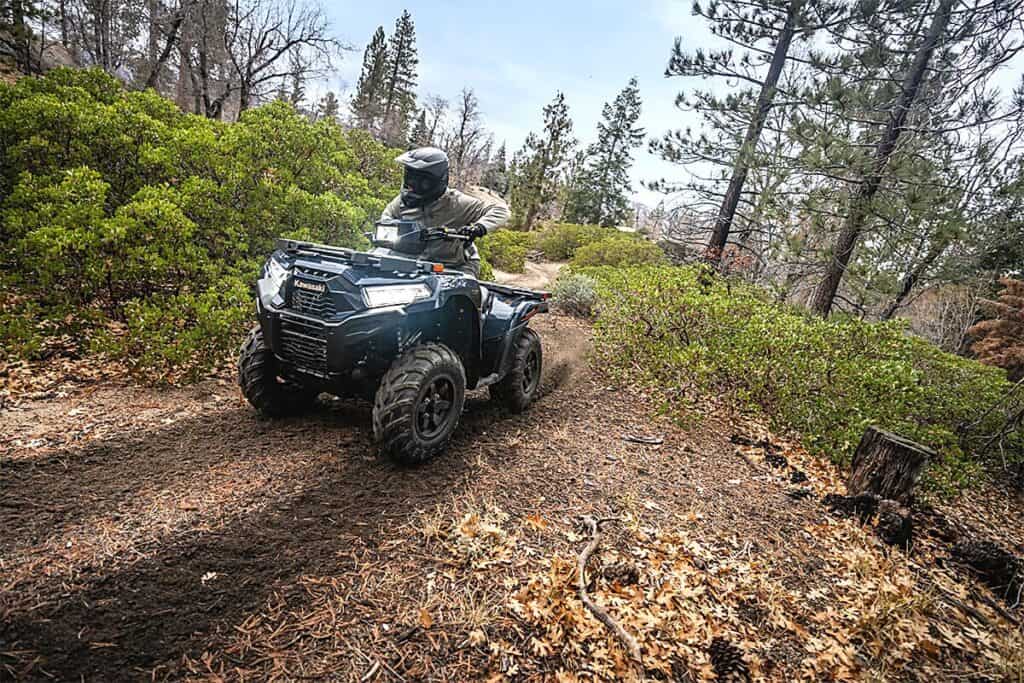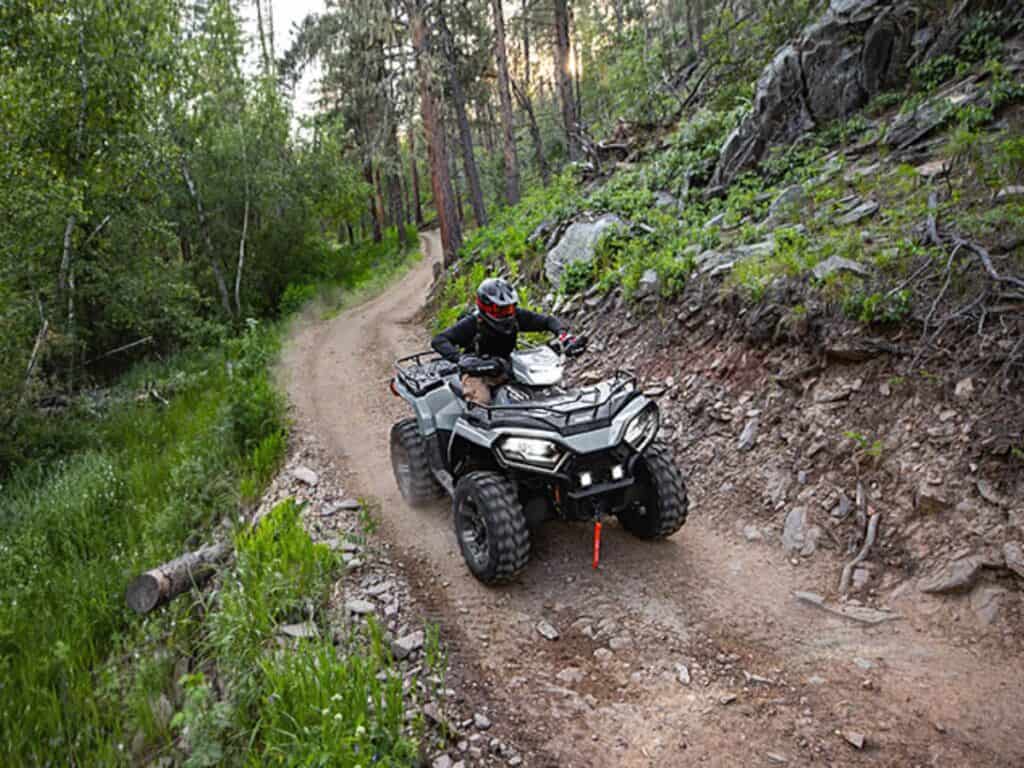One of the best ways to enjoy the great outdoors is with an all-terrain vehicle (ATV), as it allows you to access nature in a way that would never be possible in larger off-road vehicles.
If you’re new to powersports though, you probably have many questions about ATVs, like how much horsepower they have and how much can they tow.
One of the most common questions about ATVs, however, is how much they weigh, as this can affect the performance of the machine and how big of a trailer you need.
So to answer this question, we created this resource, which provides everything you need to know about ATV weight, including the weights of 20 popular models.
Key Takeaways:
- ATVs can weigh as little as 200 pounds and as much as 1,000 pounds, however, most full-size four-wheelers weigh between 400 and 800 pounds.
- Youth ATVs generally weigh between 200 and 400 pounds.
- The higher the ATV’s engine displacement, the more it will typically weigh. For example, a 200cc ATV usually weighs around 400 pounds, while a 500cc ATV typically weighs around 700 pounds.
Understanding ATV Weight
Before diving into the specifics of ATV weight, it’s important to understand what exactly we mean by “ATV weight” and why it matters.
ATV weight refers to the total weight of the vehicle, including its chassis, engine, fuel, and any additional components or accessories.
There are two common ways to express ATV weight: dry weight and wet weight.
Dry weight, also called curb weight, is the weight of the ATV without any fluids, such as fuel, oil, or coolant.
This measurement provides a standardized way to compare the base weight of different models without the variable of fluid levels.
As ATV fluids, like oil, coolant, and gas can often add anywhere from 20 to 40 pounds to the weight of a four-wheeler, depending on the model.
Wet weight takes into account the weight of the vehicle with all necessary fluids.
Because of this, wet weight is a more accurate representation of the ATV’s actual weight during operation.
Why ATV Weight Matters

Knowing and understanding ATV weight is important for four main reasons:
- Performance: Weight directly impacts a four-wheeler’s performance. Lighter ATVs generally have better acceleration, handling, and maneuverability, making them ideal for sports and recreational riding. Heavier ATVs, on the other hand, often offer better stability, traction, and towing capabilities, which are essential for utility and work-related tasks.
- Towing Capacity: ATV weight affects the vehicle’s towing capacity. Each ATV has a manufacturer-specified towing capacity, which is the maximum weight it can safely tow without compromising its performance or stability. Exceeding this limit can lead to handling issues, increased wear and tear on the vehicle, and potential safety hazards.
- Payload Capacity: ATV weight also impacts the vehicle’s payload capacity, which is the maximum weight it can carry, including riders, cargo, and accessories. Similar to towing capacity, each ATV has a manufacturer-specified payload capacity that should not be exceeded. Overloading an ATV can lead to poor handling, reduced stability, and increased stress on the vehicle’s components.
- Trailer Type and Size: The weight of an ATV will also impact the type and size of trailer you need to haul the machine. As you must ensure that the trailer’s weight capacity can safely accommodate your ATV’s wet weight, along with any additional gear or accessories you plan to transport.
Average ATV Weight Ranges
ATVs come in various sizes and styles, each designed for specific purposes and age groups.
So to help you understand the typical weight ranges for different types of ATVs, we’ve broken them down into four main categories, including youth ATVs, adult ATVs, utility ATVs, and sport ATVs.
ATV Weight Ranges by Category:
- Youth ATVs (200 – 400 Pounds) – Youth ATVs are designed for younger riders and typically have smaller engines, ranging from 50cc to 250cc. These machines are lighter in weight to accommodate the smaller size and limited strength of younger riders. On average, youth ATVs weigh between 200 and 400 pounds (90-180 kg), with the lighter models being suitable for the youngest riders and the heavier ones for older, more experienced teen riders.
- Adult ATVs (400 – 1,000 Pounds) – Adult ATVs are designed for full-size riders and offer a wide range of engine sizes, from 250cc to 1000cc. The weight of adult ATVs varies greatly depending on the engine size, features, and intended use. On average though, adult ATVs weigh between 400 and 1,000 pounds (180-450 kg), with smaller models like the 250cc class falling on the lighter end and larger, more powerful models like the 1000cc class on the heavier end.
- Utility ATVs (600 – 1,000 Pounds) – Utility ATVs are designed for work-related tasks, like farm work, and typically feature larger, more powerful engines, as well as additional features like racks, hitches, and towing capabilities. These ATVs are generally heavier than sports models due to their more robust construction and added features. On average, utility ATVs weigh between 600 and 1,000 pounds (270-450 kg), depending on the specific features and engine size.
- Sport ATVs (400 – 700 Pounds) – Alternatively, sport ATVs are designed for high-performance riding and racing. These machines prioritize speed, agility, and handling, often featuring lighter materials and streamlined designs to minimize weight. Sport ATVs typically have mid-to-high-range engine sizes, from 400cc to 600cc. On average, sport ATVs weigh between 400 and 700 pounds (180-320 kg), with the lighter models offering exceptional maneuverability and the heavier ones providing greater stability at higher speeds.
Popular ATV Models (Lightest to Heaviest)
| Make/Model/Trim | Weight | Class | Displacement | Intended Rider |
|---|---|---|---|---|
| 1. YAMAHA YFZ 50 | 220 lbs | Sport | 49cc | Youth |
| 2. Kawasaki KFX 50 | 249.2 lbs | Sport | 49cc | Youth |
| 3. Can-Am DS 70 | 250 lbs | Sport | 77cc | Youth |
| 4. Honda TRX90X | 262 lbs | Sport | 86cc | Youth |
| 5. YAMAHA GRIZZLY 90 | 308 lbs | Sport | 99cc | Youth |
| 6. Suzuki QuadSport LT-Z400 | 372 lbs | Sport | 398cc | Adult |
| 7. Honda TRX250X | 385 lbs | Sport | 229cc | Teens/Small Adults |
| 8. Yamaha YFZ450R | 405 lbs | Sport | 449cc | Adult |
| 9. Yamaha Raptor 700R SE | 422 lbs | Sport | 686cc | Adult |
| 10. Honda FourTrax Recon | 443 lbs | Utility | 229cc | Teens/Small Adults |
| 11. Kawasaki Brute Force 300 | 535.8 lbs | Utility | 271cc | Teens/Small Adults |
| 12. Yamaha Grizzly 450 | 606 lbs | Utility | 421cc | Adults |
| 13. Suzuki King Quad 450 | 606 lbs | Utility | 454cc | Adults |
| 14. Polaris Sportsman 570 | 701 lbs | Utility | 567cc | Adults |
| 15. Can-Am Renegade | 750 lbs | Sport | 650cc | Adults |
| 16. Polaris Sportsman 850 | 767 lbs | Utility | 850cc | Adults |
| 17. Arctic Cat Alterra 600 LTD | 824.1 lbs | Utility | 600cc | Adults |
| 18. Polaris Sportsman XP 1000 | 871 lbs | Utility | 952cc | Adults |
| 19. CFMoto CForce 800 XC | 1,056 lbs | Utility | 800cc | Adults |
| 20. CFMoto CForce 1000 Overland | 1,080 lbs | Utility | 963cc | Adults |
Factors that Affect the Weight of an ATV
Now that you know that ATVs can weigh anywhere from 200 to 1,000 pounds and everything in between, you might be wondering what affects the weight of a quad and why there’s such a big difference in weight from one ATV to the next.
Well, it turns out quite a few things.
Below, however, we’ve highlighted the five main factors that have the biggest impact on ATV weight.
5 Main Factors that Impact ATV Weight:
- Engine Size and Type – The engine is one of the most significant contributors to an ATV’s weight. Larger engines, such as those found in high-performance or utility models, generally weigh more than smaller engines found in youth or entry-level adult ATVs. Additionally, the type of engine (single-cylinder or twin-cylinder) can also impact the weight, as the more cylinders the engine has, often the heavier it is.
- Materials Used in Construction – The materials used to construct an ATV’s frame, body panels, and other components can greatly affect its overall weight. Manufacturers often use a combination of steel, aluminum, and plastic to balance strength, durability, and weight. Higher-end models may utilize more lightweight materials like aluminum or even carbon fiber to reduce weight without sacrificing performance.
- Suspension and Wheel Components – The type and size of suspension components, such as shocks and springs, can affect an ATV’s weight. Heavy-duty suspension systems designed for rough terrain or high-performance use may weigh more than standard components. Similarly, larger or heavier wheels and tires can contribute to increased overall weight, think deep-tread ATV mud tires.
- Additional Features and Accessories – The inclusion of additional features and accessories can add significant weight to an ATV. For example, utility ATVs often come equipped with racks, storage boxes, winches, and other work-related accessories that increase the vehicle’s overall weight.
- Fuel Capacity – The amount of fuel an ATV can hold also affects its weight. Larger fuel tanks, which are often found on utility or long-distance touring models, can add significant weight when full. For example, a 5-gallon fuel tank can add approximately 30 pounds to the ATV’s weight when filled with gasoline.
How to Determine Your ATV’s Weight

Knowing the exact weight of your ATV is important for many reasons, as mentioned above.
Which is why it’s so important to figure out the weight of your ATV.
Luckily though there are several different ways to determine the weight of your particular four-wheeler.
In fact, there are four different methods, including your owner’s manual, a commercial vehicle scale, make and model estimation, and your local dealership or service center.
Four Most Popular Ways to Determine ATV Weight:
- Check the Owner’s Manual – The most straightforward way to find your ATV’s weight is to consult the owner’s manual. Manufacturers typically include detailed specifications, including dry and wet weights, in the manual. If you don’t have a physical copy of the manual, you can often find digital versions on the manufacturer’s website or through online ATV forums.
- Use a Commercial Vehicle Scale – For the most accurate measurement, you can take your ATV to a commercial vehicle scale. Many truck stops, scrap yards, and recycling centers have scales that can accommodate ATVs. Simply drive your ATV onto the scale and record the weight.
- Estimate Based on Make and Model – If you don’t have access to the owner’s manual or a vehicle scale, you can estimate your ATV’s weight based on its make and model. Research online forums, manufacturer websites, or ATV enthusiast communities to find weight information for your specific model. Keep in mind that these estimates may not account for any modifications or accessories you’ve added to your ATV, which can affect its total weight.
- Visit a Dealership or Service Center – If you’re still unsure about your ATV’s weight, consider visiting a dealership or service center that specializes in your ATV’s brand. They should have access to detailed specifications and may even have a scale on-site to weigh your vehicle accurately.
Got More ATV Weight Questions? We’ve Got More Answers…
Additional ATV Resources:
- Can an ATV Pull a Trailer? What You Need to Know
- Do ATVs Have VIN Numbers? Decoding Vehicle Identification Numbers
- Are ATV Keys Universal? Everything You Need to Know
- Can an ATV Tow a Boat? (Understanding the Limits)
Recent Posts
Are you thinking about buying a Gator UTV? If so, you need to read this post, as we answer 10 common questions about the John Deere Gator, providing you with all the information you need to make...
In recent years, off-road enthusiasts have been taking their adventures to the next level by installing UTV underglow lights on their side-by-sides. Which adds a unique visual appeal and improves...

